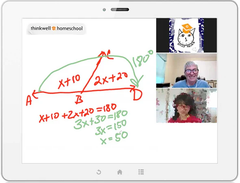3.1 Graphing Basics
3.1.1 Using the Cartesian System
3.1.2 Thinking Visually
3.2 Relationships between Two Points
3.2.1 Finding the Distance between Two Points
3.2.2 Finding the Second Endpoint of a Segment
3.3 Relationships among Three Points
3.3.1 Collinearity and Distance
3.3.2 Triangles
3.4 Circles
3.4.1 Finding the Center-Radius Form of the Equation of a Circle
3.4.2 Decoding the Circle Formula
3.4.3 Finding the Center and Radius of a Circle
3.4.4 Solving Word Problems Involving Circles
3.5 Graphing Equations
3.5.1 Graphing Equations by Locating Points
3.5.2 Finding the x- and y-Intercepts of an Equation
3.6 Function Basics
3.6.1 Functions and the Vertical Line Test
3.6.2 Identifying Functions
3.6.3 Function Notation and Finding Function Values
3.7 Working with Functions
3.7.1 Determining Intervals Over Which a Function Is Increasing
3.7.2 Evaluating Piecewise-Defined Functions for Given Values
3.7.3 Solving Word Problems Involving Functions
3.8 Function Domain and Range
3.8.1 Finding the Domain and Range of a Function
3.8.2 Domain and Range: One Explicit Example
3.8.3 Satisfying the Domain of a Function
3.9 Linear Functions: Slope
3.9.1 An Introduction to Slope
3.9.2 Finding the Slope of a Line Given Two Points
3.9.3 Interpreting Slope from a Graph
3.9.4 Graphing a Line Using Point and Slope
3.10 Equations of a Line
3.10.1 Writing an Equation in Slope-Intercept Form
3.10.2 Writing an Equation Given Two Points
3.10.3 Writing an Equation in Point-Slope Form
3.10.4 Matching a Slope-Intercept Equation with Its Graph
3.10.5 Slope for Parallel and Perpendicular Lines
3.11 Linear Functions: Applications
3.11.1 Constructing Linear Function Models of Data
3.11.2 Linear Cost and Revenue Functions
3.12 Graphing Functions
3.12.1 Graphing Some Important Functions
3.12.2 Graphing Piecewise-Defined Functions
3.12.3 Matching Equations with Their Graphs
3.13 The Greatest Integer Function
3.13.1 The Greatest Integer Function
3.13.2 Graphing the Greatest Integer Function
3.14 Quadratic Functions: Basics
3.14.1 Deconstructing the Graph of a Quadratic Function
3.14.2 Nice-Looking Parabolas
3.14.3 Using Discriminants to Graph Parabolas
3.14.4 Maximum Height in the Real World
3.15 Quadratic Functions: The Vertex
3.15.1 Finding the Vertex by Completing the Square
3.15.2 Using the Vertex to Write the Quadratic Equation
3.15.3 Finding the Maximum or Minimum of a Quadratic
3.15.4 Graphing Parabolas
3.16 Manipulating Graphs: Shifts and Stretches
3.16.1 Shifting Curves along Axes
3.16.2 Shifting or Translating Curves along Axes
3.16.3 Stretching a Graph
3.16.4 Graphing Quadratics Using Patterns
3.17 Manipulating Graphs: Symmetry and Reflections
3.17.1 Determining Symmetry
3.17.2 Reflections
3.17.3 Reflecting Specific Functions
3.18 Composite Functions
3.18.1 Using Operations on Functions
3.18.2 Composite Functions
3.18.3 Components of Composite Functions
3.18.4 Finding Functions That Form a Given Composite
3.18.5 Finding the Difference Quotient of a Function
3.18.6 Calculating the Average Rate of Change









